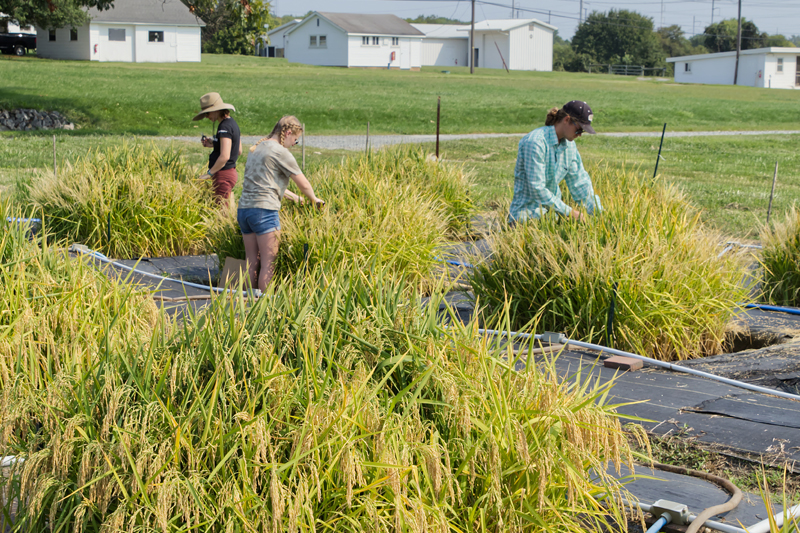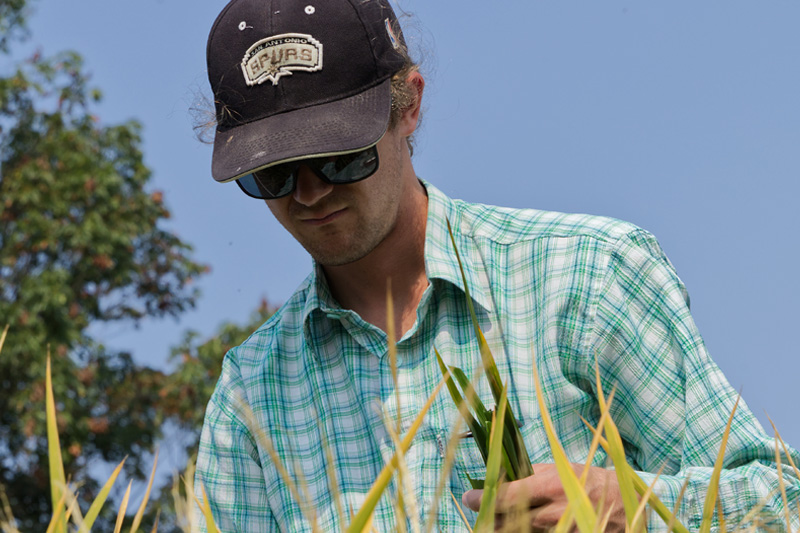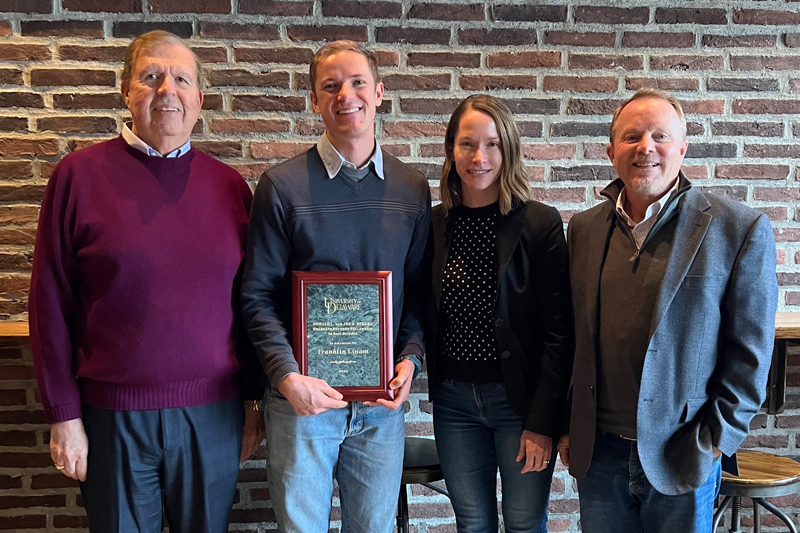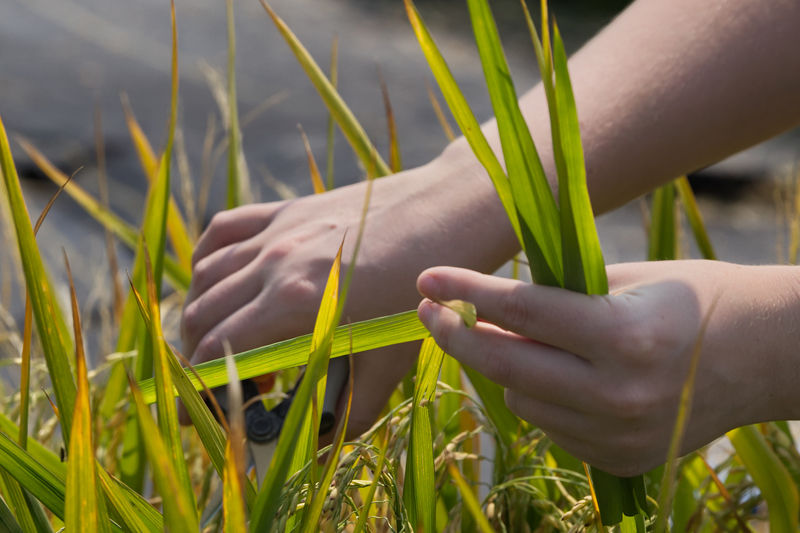


Decoding rice roots
Photos by Monica Moriak and courtesy of Frank Linam April 26, 2024
Doctoral student Frank Linam explores how wet soil conditions in flooded rice paddies affect the way roots take in nutrients and filter out toxins
More than 3 billion people around the world eat rice as a regular part of their diet — and this grain can hold its own. When submerged in flooded soils, many plants can’t breathe and are too stressed to grow, but rice can survive and even thrive.
Frank Linam, a plant and soil sciences doctoral student at the University of Delaware, is studying how the wet soil conditions in flooded rice paddies affect the way the roots take in nutrients and filter out toxins.
“The flooded soil in rice fields is really unique compared to other crops, which makes it a really fun area to study,” said Linam, who recently received the Donald and Joy Sparks Fellowship in Plant Science.
In wet soils, rice can survive in low oxygen environments by forming tube-like structures in its roots that allow the plant to bring oxygen to the roots. The introduction of oxygen into the flooded soil causes new minerals to form, most notably iron oxide minerals, creating an iron plaque layer.
“The iron plaque layer essentially acts as a filter for the plant, allowing nutrients to get in while stopping possible contaminants,” said Angelia Seyfferth, professor of biogeochemistry and plant-soil interactions and Linam’s advisor.
There is a caveat to this idea, though: Many researchers in the field speculated that since the iron plaque layer collects toxins, like arsenic, right next to the plant, it could potentially become a source of that toxin for the plant.
Seyfferth explained that arsenic is similar to some essential nutrients for rice. It can change its form in certain environments and can mimic phosphorus — a mineral that’s vital for plant growth.
“We were wondering, if while the plant is trying to access phosphorus that might be on that plaque layer, is it accidentally getting some arsenic?” Seyfferth said.
Linam found that the plaque successfully holds onto the arsenic in various environments and soil types so that it doesn’t make it into the roots.

“His work suggests that the plaque layer is actually a really good thing for preventing how much arsenic ultimately gets transported to the grain that we then eat, so it’s good news,” Seyfferth said.
Linam’s research on the kinds of toxins in rice and how much can invade just one grain will be key to understanding how much toxins can be introduced to the human diet through eating this food.
“I came to UD originally because Dr. Seyfferth’s research was so interesting,” Linam said. “The way that rice is able to take up the nutrients from the soil through its roots is really different. Something really interesting that we’re figuring out now is how different soil textures affect the oxygenation around the roots.”
Linam explained that as the oxygen is leaking out of the rice roots to form the plaque layer, the roots are taking in water, which brings new nutrients and toxins to the roots.
“We’re trying to figure out the relative rate of oxygen entering soil versus water entering the plant in different soil textures, and we study all that out in the rice paddies on the [UD Newark Farm] as well as the greenhouse and the lab,” Linam said.
The Seyfferth Lab specifically designed and built these experimental paddy rice plots for research and outreach. The real advantage to the fields, though, is that they’re so close in proximity to their lab, meaning they can easily gather lots of data over time.
Linam’s research has taken him far beyond their experimental rice paddies on the UD Newark Farm, leading him to conferences in Arkansas, Scotland and China.
At the the 15th International Conference on Biogeochemistry of Trace Elements in China, Linam presented his research through a prestigious U.S. Department of Agriculture predoctoral fellowship.

“It’s great to go there and see what people in more applied areas are doing,” Linam said. “Being able to travel to these different conferences and meet people from different countries is really cool.”
Seyfferth said sharing research is an integral part of being a scientist, especially in Linam’s discipline. Getting information out to growers and sharing data can make a huge impact in the ever-changing agriculture industry.
“One of the unique things about [Linam] and one of the talents of a successful scientist is having the ability to talk on a high level to other experts, but also translate that information to the common person so that they understand what you’re doing and why it’s important,” Seyfferth said.
After his doctoral studies, Linam plans on continuing his work with rice roots and their interactions with the soil through postdoctoral studies. He hopes to eventually work in academia long-term.
Some of the mechanisms Linam wants to further delve into are the ways that rice roots can exude different molecules that in turn make it easier for the roots to take in the essential nutrients that reside in the soil.
Once Linam’s research can reach extension agents and rice producers, real progress can be made in the cultivation and conservation of rice for the billions of people who eat the grain every day.
“One thing I want to keep doing in the future is looking at more specific mechanisms of how the roots interact with the soil,” Linam said. “No one knows a lot about things happening below ground, so being able to look at differences across genotypes or species and how their roots grow can increase our efficiency of plant production and conservation.”

Contact Us
Have a UDaily story idea?
Contact us at ocm@udel.edu
Members of the press
Contact us at 302-831-NEWS or visit the Media Relations website

